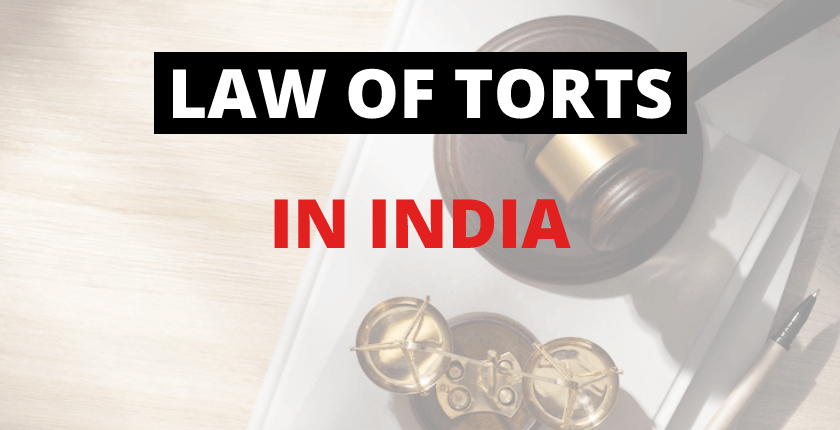Contents
BOOK A FREE DEMO CLASS ?
A tort is a civil wrong that can be remedied through the award of damages. The beginning of the word tort can be traced back to the Latin verb, tortum, which means ‘to twist’, ‘warp’ or ‘twist’. The word is often cited as “ut tu frangas, alter ne frangat borrowing from a work by Cicero who said; “ut tu frangere possis alienam personam, alter ne frangere cogatur absentem.” In other words, if you can twist another’s property without his consent, he is expected to make sure that no one else twists his own. The law of torts is the area of law that covers such wrongs. The purpose of the law of torts is to provide a remedy for the victim of a tortious act. The law of torts is also designed to deter potential tortfeasors from committing tortious acts.
There are three main types of torts: negligence, intentional, and strict liability. Negligence is when someone accidentally causes harm to another person. Intentional torts are when someone deliberately causes harm to another person. Strict liability torts are when someone is held liable for harm even if they did not intend to cause it.
| You Can Also Check | |
| OPUS CLAT Offline Full Test | Download Now |
| OPUS AILET Offline Full Test | Download Now |
| Try Out our Online CLAT Mocks | |
| CLAT Mock Test | |
If you are a victim of a tort, you should seek legal advice from a solicitor as soon as possible. If you have suffered personal injury or damage to your property, you may be able to claim compensation from the person who caused the accident. The law of torts is a complex area of law and it is important to get specialist advice to ensure that you receive the compensation you are entitled to.
There are a few ways that you can avoid committing a tort. The first way is to be aware of what the law of torts is and what it covers. This means knowing what your rights are and what the rights of others are. The second way to avoid committing a tort is to take care not to cause harm to others. This means being careful not to do anything that could reasonably be expected to cause harm. The third way to avoid committing a tort is to take care not to break the law. This means obeying all laws and regulations that apply to you.
The law of torts is a legal area that covers civil wrongs and injuries. Torts can be intentional or unintentional, and the consequences can be severe. If you commit a tort, you may be liable for damages, which can include monetary damages, pain and suffering, and emotional distress. You may also be ordered to pay punitive damages, which are designed to punish the wrongdoer and deter others from similar behavior. In some cases, you may also be required to pay the attorney’s fees and court costs of the person who sues you. If you are found guilty of a crime, you may be subject to criminal penalties, which can include a fine, imprisonment, or both.
Law of torts in the Indian Context
Law of torts in India
The law of torts in India has developed over a period of time. It is based on the English common law of torts, but has been modified to suit the Indian legal system. The law of torts is concerned with the civil wrongs which are not covered by the criminal law. The purpose of this article is to provide an overview of the law of torts in India.
The Law of Torts in the Indian context is codified in Section 2(3) of the Civil Procedure Code. As per this law, tort refers to civil wrong that may be rectified by a court of law, except where it is said that no recovery can be had under the civil legal system.
In India, the law of torts serves a policy function and derives its authority from the principles of natural justice. The Indian judiciary has also elaborated rules, principles and norms with regard to a number of issues which have emerged in course of time.
The law of torts governs civil wrongs, and includes contract, delict, strict liability and quasi-delict. These tortious acts are considered per se not only criminal but also civil in character. The Central Civil Procedure Code (Procedure Code) has been criticised for being inconsistent with the principle of natural justice; as such it is seen by some scholars as subsuming the ‘irrational’ elements of tort law into a broader forum to ensure that natural justice is met.
The legal action that a party may take against another when he has been injured by the wrongful act of another.
Law of torts in the Indian context is highly relevant – because a substantial part of activity of all Indian industries involves making legal and illegal business. Most important part is that if a person does something to harm another or cause injury, then he may be liable for damage caused. It is not enough to make an injury, the injury should also have been caused intentionally or negligently.
Law of torts in the Indian context, tort law has evolved from equitable principles to deal with civil wrongs. Two distinct branches of tort law have evolved in India – delicts and contracts.
Law of torts is the branch of law that deals with civil liability. In India, the law governing tort is a blend of Roman-Dutch and English legal traditions. The principal exceptions are those areas where the Indian legal system has drawn on experiences derived from common law systems as well as those areas which have not been affected by foreign influences or influences of foreign origin in any respect.
The law of torts in India has not just a jurisprudential basis but also a statutory basis. It is governed by Indian laws and also the laws in force in other countries that have signed bilateral agreements with India.
Law of torts in India
In India, the law of torts is codified in the Indian Penal Code, 1860. The code contains a comprehensive list of tortious acts and the corresponding punishments. The law of torts in India is thus largely based on English common law, with some modifications.
The most common tortious act in India is defamation, which is punishable by up to two years’ imprisonment and/or a fine. Other common tortious acts include assault, battery, false imprisonment, malicious prosecution, and trespass.
The law of torts in India provides for both civil and criminal liability. In general, civil liability is imposed for compensatory damages, while criminal liability is imposed for punitive damages. However, there are some exceptions to this rule, such as in the case of defamation, where both civil and criminal liability may be imposed.
The Indian courts have held that the principles of strict liability apply to certain types of torts, such as those involving defective products or dangerous premises. In these cases, the person who suffers damage does not need to prove that the person who caused the damage was at fault. This rule is based on the principle that it is better to prevent harm than to compensate for it after the fact.
What is a tort?
A tort is a civil wrong that can be committed by an individual, company, or other legal entity. In India, the law of torts is codified in the Indian Penal Code, 1860. Torts can be either intentional or unintentional. Intentional torts are those which are committed with the intention to cause harm, while unintentional torts are those which are committed without the intention to cause harm.
The law of torts in India provides for a variety of remedies including damages, injunction, and restitution. Damages are awarded to the victim to compensate him/her for the loss suffered. Injunctions are orders of the court that prohibit the defendant from committing a particular act. Restitution is a remedy which requires the defendant to return any property that he/she has acquired as a result of the tortious act.
The different types of torts in India
There are many different types of torts in India. The most common type of tort is negligence. This is when someone does something that they should not have done, or did not do something that they should have done, and this results in harm to another person. Other types of torts include intentional torts (such as assault and battery), strict liability torts (such as products liability), and defamation.
Torts can be either civil or criminal in nature. In a civil tort, the victim can sue the wrongdoer for damages. In a criminal tort, the wrongdoer can be prosecuted by the state for their actions.
If you have been the victim of a tort, it is important to speak with an experienced lawyer who can help you understand your legal rights and options.
The law of negligence
The law of negligence in India is based on the English common law of negligence. The principles of negligence have been codified in the Indian Penal Code, 1860. Under the Indian Penal Code, 1860, there is a provision for compensation for death or injury caused by the negligence of another person. The amount of compensation is determined by the court. The law of negligence in India is not static and is constantly evolving.
Defamation
In India, defamation is a civil wrong and is punishable under law. The Indian Penal Code, 1860 defines defamation as follows:
“Whoever, by words either spoken or intended to be read, or by signs or by visible representations, makes or publishes any imputation concerning any person intending to cause damage, or knowing or having reason to believe that such imputation will cause damage, is said to defame that person.”
Defamation can be both a criminal and a civil offence. In a civil case, the burden of proof lies on the person who has been defamed to prove that the imputation made against him is false and has caused him damage. On the other hand, in a criminal case, it is for the prosecution to prove beyond reasonable doubt that the imputation made is false and has caused injury to the reputation of the person concerned.
The punishment for defamation may vary from simple imprisonment for a term which may extend to two years, or with fine, or with both.
Assault and battery
In India, the law of torts is codified under the Indian Penal Code, 1860. TheCode defines assault as “when a person makes an attempt to cause physical harm to another person”. Battery is defined as “when a person intentionally causes physical harm to another person”. In order to constitute an assault or battery, there must be an intention to cause physical harm.
Under the law of torts, an assault is considered a civil wrong and can be prosecuted in a civil court. A battery is considered a criminal wrong and can be prosecuted in a criminal court.
The law of torts in India provides for both compensatory and punitive damages. Compensatory damages are intended to compensate the victim for the injuries suffered. Punitive damages are intended to punish the wrongdoer and deter others from committing similar acts.
False Imprisonment
False imprisonment is a criminal offence that entails the arrest of a person who was never under suspicion. It can include any number of actions, including restraining them through force or threat, restraining them with no intention to arrest them and dumping them at an unknown location. It’s an act that involves the three parts of the crime — actus reus, mens rea and causation
Malicious Prosecution
The term “malicious prosecution” refers to a civil cause of action that arises when a plaintiff believes that the state’s attorney has acted maliciously or in bad faith in bringing charges against her. Malicious prosecution is a cause of action under both state and federal law. The concept can be traced to ancient Roman law, and similar doctrines have been used in English common law for centuries.
Copyright Infringement
Copyrights are protected under the law, which means that you need to take action against someone who is using your intellectual property without your permission. In general, this type of activity involves credit, data or computer programs in a work that has been published and is available to the public.
Copyrights are protected under the law, which means that you need to take action against someone who is using your intellectual property without your permission. In general, this type of activity involves credit, data or computer programs in a work that has been published and is available to the public
The Origin Of Tort Law
Before the French, William the Conqueror’s 1066 Norman conquest of England, the legal system was somewhat inconsistent, conducted on a more-or-less case-by-case basis by the king and his advisors. It wasn’t until 1215 that the Magna Carta was signed, which set down some basic rules for how disputes were to be settled. and based on local customs and practices. The first written laws were issued by William the Conqueror in 1087, but these were mostly concerned with property rights and inheritance. The first real attempt at codifying English law was King Edward I’s Statute of Westminster in 1275. It set down a number of basic principles, including the rule that “no one shall be imprisoned or deprived of his freehold, liberties or privileges except by lawful judgment of his peers or by the law of the land.” In the late 14th century, a group of English lawyers called the “lawyers’ clerks” began to draft more detailed “statutes.” These were official laws that set down specific rules for how disputes were to be settled. The Statute of Westminster also said that judges were not to be subject to the king’s will but had to decide cases according to their own conscience and knowledge of the law. This was a major step forward, but it still left many questions unresolved. The Statute of Westminster also prohibited torture and established that no man could be tried twice for the same offence. However, the Statute of Westminster didn’t actually set out any laws that could be enforced, so it was still up to local judges and officials to interpret what was “lawful.” In 1362, Parliament issued its first criminal code for England, but this was only concerned with crimes against the state (such as treason). This was the basis for the rule that no one could be imprisoned without due process of law. The Statute also established that juries should consist of local people who knew the accused and could judge him fairly. The Magna Carta was one of the most important documents in the history of English law. It established that no free man could be imprisoned or punished except by lawful judgement of his peers or a jury, and it set out certain rights including freedom from taxes without consent, fair treatment for all under the law, access to swift justice, protection against unfair imprisonment and torture. The Magna Carta was one of the most important documents in the history of English law. It established that no free man could be imprisoned or punished except by lawful judgement of his peers or a jury, and it set out certain rights including freedom from taxes without consent, fair treatment for all under the law, access to swift justice, protection against unfair imprisonment and torture. Basically, the Law Of Torts provides protection to a society in general against wrongdoings.
Register for Free Demo: CLAT Online Classes | CLAT Crash Course | CLAT Mock TestHope you learned something today =)
We're super excited to connect with you
Book a session with Us For FREE
You can choose to connect with a counsellor or scheudle a free trial class with us ✨🚀



